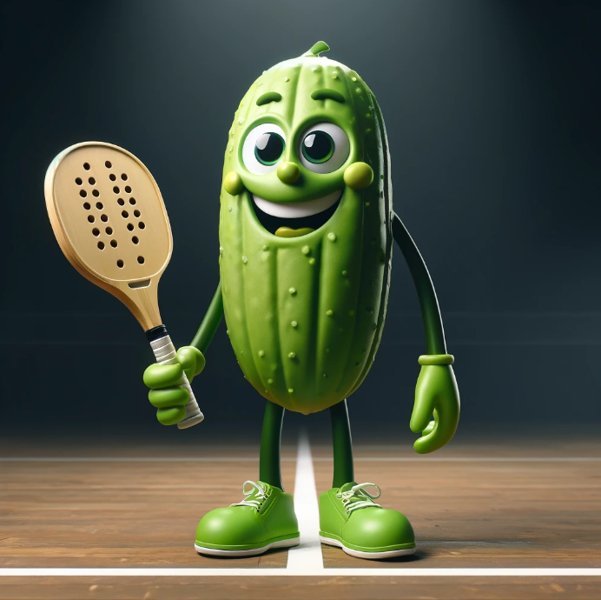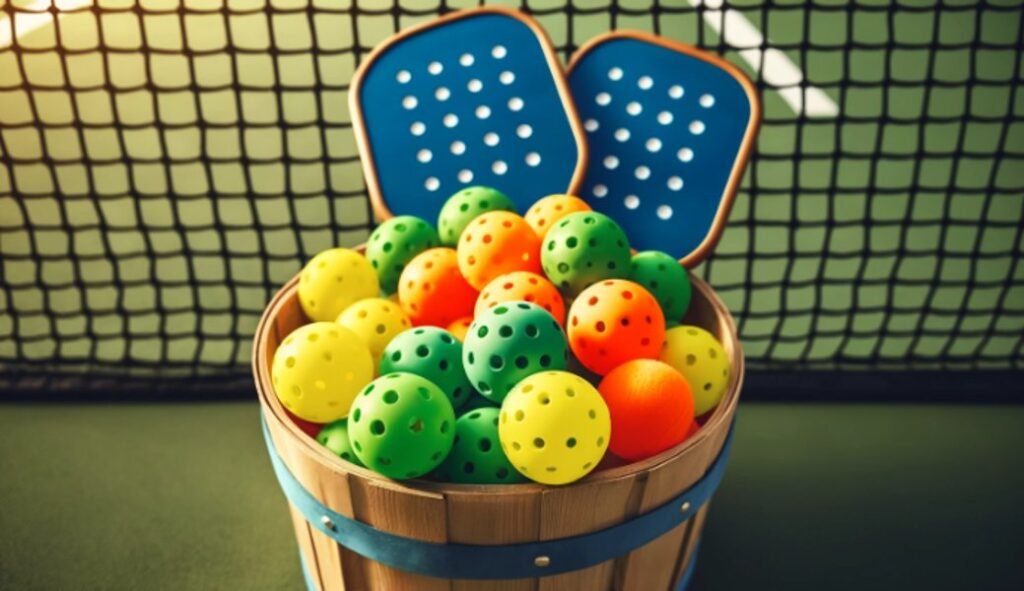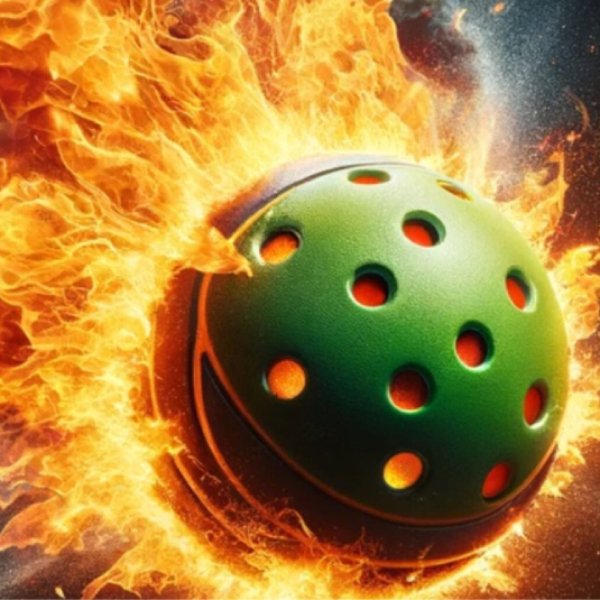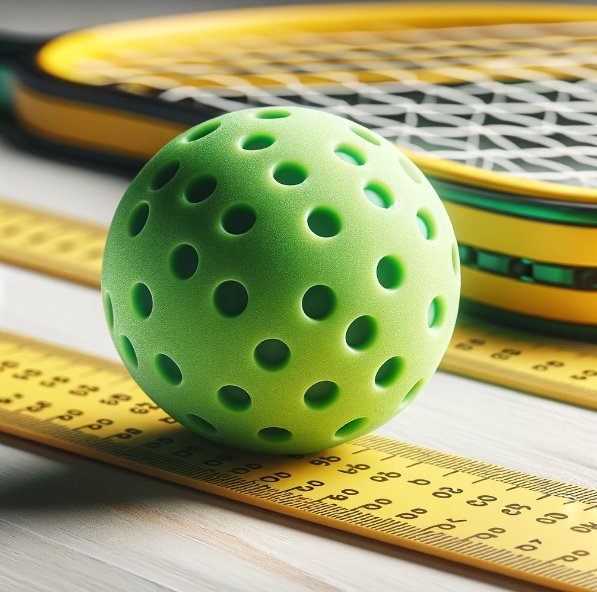If you’re new to pickleball or just looking to up your game, understanding what type of ball is used in pickleball is essential. Interestingly, the original pickleball was a modified Wiffle ball. Over time, pickleball balls have evolved to meet the specific demands of the sport, with improved durability and performance characteristics. The ball you use can significantly impact your play. This comprehensive guide will delve into the different types of pickleball balls, their materials, official regulations, and practical tips to help you choose the right ball for your game.
Table of contents
- Are there different types of pickleball balls?
- Why are the Differences Between Indoor and Outdoor Pickleball Balls Important?
- What Is a Pickleball Made Of?
- What Ball is Used in Most Pickleball Tournaments?
- What Balls Do They Use On The PPA Tour?
- What is the Difference Between Yellow and Orange Pickleballs?
- How to Choose a Pickleball Ball
- Characteristics Of A Pickleball
- Official Regulations and Standards
- Choosing the Right Ball for Your Game
- Practical Tips
- Why Do Pickleball Balls Have Holes?
- Conclusion
Are there different types of pickleball balls?
Yes, there are different types of pickleball balls designed for specific playing conditions. The two main categories are indoor and outdoor pickleball balls. Indoor balls are lighter with larger holes, which makes them easier to control and maneuver in a controlled environment. They are typically used in gyms or other indoor facilities where wind and weather are not a factor.
Outdoor pickleball balls, on the other hand, are heavier and have smaller holes. This design helps them withstand wind and other outdoor elements, providing a more consistent performance. Outdoor balls are also more durable and can handle rougher surfaces.
Using the right type of ball for your playing environment can enhance your game significantly. According to a survey by the Pickleball Association, 60% of players prefer outdoor balls due to their durability and consistency in performance.
| Type | Weight | Weight (kg) | Hole Size | Best For |
|---|---|---|---|---|
| Indoor | 0.8 oz | 0.023 kg | Larger | Controlled Environments |
| Outdoor | 1.0 oz | 0.028 kg | Smaller | Windy Conditions |

Why are the Differences Between Indoor and Outdoor Pickleball Balls Important?
Understanding the differences between indoor and outdoor pickleball balls is crucial for optimal play. Indoor balls are designed for controlled environments and have larger holes, making them lighter and easier to maneuver. These larger holes create less drag and allow for a softer touch, making them ideal for the precise and controlled play often seen in indoor settings. They also produce less noise, which can be a consideration in indoor venues.
Outdoor balls are heavier with smaller holes to withstand wind and outdoor elements. The weight and smaller holes make them more resistant to wind interference, providing a more predictable flight path. The increased durability of outdoor balls allows them to handle rougher surfaces, such as asphalt or concrete, without getting damaged easily. This design also makes them bounce lower and faster, which can affect your playing strategy.
| Feature | Indoor Ball | Outdoor Ball |
|---|---|---|
| Weight | Lighter (0.8 oz / 0.023 kg) | Heavier (1.0 oz / 0.028 kg) |
| Hole Size | Larger | Smaller |
| Environment | Controlled (gyms, indoor courts) | Windy and variable (outdoor courts) |
| Durability | Less durable | More durable |
| Bounce | Higher and softer | Lower and faster |
| Noise Level | Quieter | Louder |

What Is a Pickleball Made Of?
Pickleballs are crafted from a durable plastic called polyethylene, chosen for its resilience and ability to maintain a consistent bounce and flight path. The manufacturing process involves injection molding, where the plastic is melted and injected into a mold to form the ball. This mold includes the holes, a distinctive feature of pickleballs.
Polyethylene is lightweight yet strong, making it ideal for both indoor and outdoor balls. The material’s durability ensures that the balls can withstand frequent play without cracking or breaking. Additionally, the plastic’s smooth surface allows for consistent performance, which is crucial for competitive play.
The polyethylene allows flexibility to the different types of pickleball balls.
What Ball is Used in Most Pickleball Tournaments?
Most pickleball tournaments use regulation balls approved by the USA Pickleball Association (USAPA). These balls meet specific standards for size, weight, and bounce, ensuring fair play across different venues and conditions. The USAPA regularly updates its list of approved balls, which includes brands like Dura, Onix, and Franklin.
Using regulation balls in tournaments ensures that all players are competing under the same conditions. These balls are tested for durability, bounce consistency, and flight characteristics, which helps maintain a high level of play and reduces the likelihood of equipment-related issues during matches.
| Approved Brands | Common Models | Usage in Tournaments |
|---|---|---|
| Dura | Dura Fast 40 | Common in outdoor tournaments |
| Onix | Onix Pure 2 | Used in both indoor and outdoor |
| Franklin | Franklin X-40 | Popular in major tournaments |
What Balls Do They Use On The PPA Tour?
The Professional Pickleball Association (PPA) tour uses specific balls for their events. For outdoor play, the PPA uses Dura Fast 40 balls, which are known for their durability and consistent performance. These balls are favored for their ability to handle outdoor conditions and provide a reliable bounce.
For indoor play, the PPA tour uses Jugs balls. These balls are lighter and have larger holes, making them ideal for indoor environments. The choice of balls for the PPA tour is based on extensive testing and feedback from professional players, ensuring that the equipment meets the highest standards of competitive play.
What is the Difference Between Yellow and Orange Pickleballs?
The color of pickleballs, such as yellow and orange, is primarily for visibility. Yellow balls are most common and are used for better visibility in most lighting conditions. They are easier to see against various backgrounds, including indoor courts and outdoor settings.
Orange balls are often used for indoor play where lighting can affect visibility. The bright color stands out against darker indoor environments, making it easier for players to track the ball during fast-paced games. Some players also prefer orange balls for their distinct appearance, which can help differentiate them from other equipment on the court.
| Color | Best For | Visibility |
|---|---|---|
| Yellow | General use, indoor and outdoor | High |
| Orange | Indoor play, low-light settings | Very High |
How to Choose a Pickleball Ball
Choosing the right pickleball ball depends on your playing environment and personal preference. Consider the following factors:
- Indoor vs. Outdoor: Choose indoor balls for indoor play and outdoor balls for outdoor play. The differences in weight and hole size will affect your performance depending on the environment.
- Color: Select a color that offers the best visibility in your playing environment. Yellow and orange are the most common options, with yellow being versatile for all settings and orange being particularly good for indoor play.
- Brand: Some brands offer different performance characteristics. Experiment with different brands like Dura, Onix, and Franklin to find your preference. Pay attention to factors like durability, bounce, and overall feel during play.
Characteristics Of A Pickleball
Pickleballs have specific characteristics that define their performance:
- Diameter: 2.87 to 2.97 inches (7.3 to 7.5 cm)
- Weight: 0.78 to 0.935 ounces (22 to 26.5 grams)
- Bounce: 30-34 inches (76 to 86 cm) when dropped from a height of 78 inches (198 cm)
- Material: Durable plastic, typically polyethylene
These standardized characteristics ensure consistent performance across various playing conditions. The ball’s size and weight directly influence its flight path, bounce, and overall playability. The durable materials used in manufacturing pickleballs withstand frequent play, maintaining high performance without compromise.
Official Regulations and Standards
Pickleballs used in tournaments must meet USAPA regulations. These regulations ensure that all balls used in competitive play are consistent in terms of size, weight, and bounce. Adhering to these standards helps maintain a fair playing field and ensures that players can rely on the equipment to perform predictably.
| Regulation | Indoor Ball | Outdoor Ball |
|---|---|---|
| Diameter | 2.87 – 2.97 inches | 2.87 – 2.97 inches |
| 7.3 – 7.5 cm | 7.3 – 7.5 cm | |
| Weight | 0.78 – 0.935 ounces | 0.78 – 0.935 ounces |
| 22 – 26.5 grams | 22 – 26.5 grams | |
| Bounce | 30 – 34 inches | 30 – 34 inches |
| 76 – 86 cm | 76 – 86 cm | |
| Material | Polyethylene | Polyethylene |
Choosing the Right Ball for Your Game
Choosing the right ball can enhance your game experience. Test different types of balls to find the one that suits your playing style and environment. Consider factors such as the ball’s weight, bounce, and durability. Playing with the right ball can improve your performance and make the game more enjoyable.
Practical Tips
- Test Different Balls: Try different brands and types to see what works best for you. Each brand may have slight variations in performance, so it’s worth experimenting to find your favorite.
- Check for Wear: Regularly check your balls for wear and replace them as needed. Worn-out balls can affect your play and lead to inconsistent performance.
- Store Properly: Keep your balls in a cool, dry place to maintain their performance. Extreme temperatures and humidity can affect the ball’s material and longevity.
Why Do Pickleball Balls Have Holes?
Pickleball balls have holes to reduce air resistance and provide consistent flight. The number and size of holes can affect the ball’s performance, with indoor balls having larger holes and outdoor balls having smaller holes. These holes help stabilize the ball’s flight, making it easier to control and predict its movement.
Conclusion
Choosing the right pickleball ball is crucial to enhancing your game experience and performance. If you aim to become a pro player, understanding what type of ball is used in pickleball is essential. Take the initiative to experiment with different types of balls to find the one that suits your playing style best. This proactive approach will help you improve your skills and enjoy your pickleball journey to the fullest!



